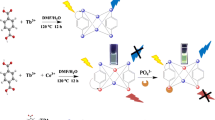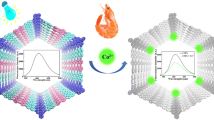Abstract
By serving dipyridylic acid (DPA) and 2,5-dihydroxyterephthalic acid (DHTA) as the biligands, a novel lanthanide (Eu3+) metal–organic framework (MOF) namely Eu-DHTA/DPA was prepared for specific Hg2+ fluorescence determination. The dual-ligand approach can endows the resulting luminescent MOF with dual emission of ratiometric fluorescence and uniform size. Eu3+ produces intense red fluorescence when activated by the ligand DPA, while the other ligand DHTA produces yellow fluorescence. Under 273 nm excitation, the presence of Hg2+ in the monitoring environment causes an increase in the intensity of the DHTA fluorescence peak at 559 nm and a decrease in the intensity of the Eu3+ fluorescence peak at 616 nm. Hg2+ effectively quenches the fluorescence emission of the central metal Eu3+ in Eu-DHTA/DPA at 616 nm through a dynamic quenching effect. This recognition process occurs due to the coordination of Hg2+ with ligands such as benzene rings, carboxyl groups, and pyridine N in three-dimensional space. Hg2+ was detected by measuring the ratio between two fluorescence peaks (I559 nm/I616 nm) within the range 2—20 μM, achieving a remarkably low detection limit of 40 nM. The established ratiometric fluorescence method has been successfully applied to the determination of Hg2+ in industrial wastewater of complex composition. The method plays a crucial role in the rapid and sensitive monitoring of Hg2+ in real environmental samples. The recoveries ranged from 92.82% to 112.67% (n = 3) with relative standard deviations (RSD) below 4.8%. This study offers a convenient and effective method for constructing probes for Hg2+ monitoring, with practical applications in environmental monitoring.
Graphical abstract







Similar content being viewed by others
Data availability
Data will be made available on request.
References
Dai D, Yang J, Wang Y, Yang Y-W (2021) Recent Progress in Functional Materials for Selective Detection and Removal of Mercury(II) Ions. Adv Funct Mater 31:2006168. https://doi.org/10.1002/adfm.202006168
European Parliament and Council of the European Union (2010) Directive 2010/75/EU of the European Parliament and Council of 24 November 2010 on industrial emissions (integrated pollution prevention and control) (Recast). https://eur-lex.europa.eu/legal-content/EN/ALL/?uri=CELEX:32010L0075. Accessed 12 May 2023
Ministry of Ecology and Environment of the People's Republic of China (2014) Emission standards of pollutants for stannum, antimony and mercury Industries. https://www.mee.gov.cn/ywgz/fgbz/bz/bzwb/dqhjbh/dqgdwrywrwpfbz/201405/t20140530_276308.shtml. Accessed 12 May 2023
Bonemann D, Souza A, Pereira C, Oreste E, Ribeiro A, Vieira M (2021) Determination of Hg in xanthan gum by CV AAS after acid decomposition using reflux system. Food Hydrocoll 118:106802. https://doi.org/10.1016/j.foodhyd.2021.106802
Santos MVS, da Silva Júnior JB, de Carvalho CEV, dos Santos Vergílio C, Hadlich GM, de Santana CO, de Jesus TB (2020) Geochemical evaluation of potentially toxic elements determined in surface sediment collected in an area under the influence of gold mining. Mar Pollut Bull 158:111384. https://doi.org/10.1016/j.marpolbul.2020.111384
Wang Y, Liu G, Li Y, Liu Y, Guo Y, Shi J, Hu L, Cai Y, Yin Y, Jiang G (2020) Occurrence of Mercurous [Hg(I)] Species in Environmental Solid Matrices as Probed by Mild 2-Mercaptoethanol Extraction and HPLC-ICP-MS Analysis. Environ Sci Technol Lett 7:482–488. https://doi.org/10.1021/acs.estlett.0c00329
Guo X, Chen F, Wang F, Wu Y, Ying Y, Wen Y, Yang H, Ke Q (2020) Recyclable Raman chip for detection of trace Mercury ions. Chem Eng J 390:124528. https://doi.org/10.1016/j.cej.2020.124528
Song Y, Guo F, Zeng P, Liu J, Wang Y, Cheng H (2022) Simultaneous measurements of Cr, Cd, Hg and Pb species in ng L−1 levels by interfacing high performance liquid chromatography and inductively coupled plasma mass spectrometry. Anal Chim Acta 1212:339935. https://doi.org/10.1016/j.aca.2022.339935
Gao F, Zhan F, Li S, Antwi-Mensah P, Niu L, Wang Q (2022) Dual signal-based electrochemical aptasensor for simultaneous detection of Lead(II) and Mercury(II) in environmental water samples. Biosens Bioelectron 209:114280. https://doi.org/10.1016/j.bios.2022.114280
Bushira FA, Kitte SA, Xu C, Li H, Zheng L, Wang P, Jin Y (2021) Two-Dimensional-Plasmon-Boosted Iron Single-Atom Electrochemiluminescence for the Ultrasensitive Detection of Dopamine, Hemin, and Mercury. Anal Chem 93:9949–9957. https://doi.org/10.1021/acs.analchem.1c02232
Huang Y, Li F, Ma G, Yang W, Zhang X, Lin J, Luo Y, Huang P (2018) Aggregation induced photoacoustic detection of mercury (II) ions using quaternary ammonium group-capped gold nanorods. Talanta 187:65–72. https://doi.org/10.1016/j.talanta.2018.05.002
Chen S-Y, Li Z, Li K, Yu X-Q (2021) Small molecular fluorescent probes for the detection of lead, cadmium and mercury ions. Coord Chem Rev 429:213691. https://doi.org/10.1016/j.ccr.2020.213691
Neupane LN, Park J, Mehta PK, Oh E-T, Park HJ, Lee K-H (2020) Fast and sensitive fluorescent detection of inorganic mercury species and methylmercury using a fluorescent probe based on the displacement reaction of arylboronic acid with the mercury species. Chem Commun 56:2941–2944. https://doi.org/10.1039/C9CC09240D
Radwan A, El-Sewify IM, Shahat A, Azzazy HME, Khalil MMH, El-Shahat MF (2020) Multiuse Al-MOF Chemosensors for Visual Detection and Removal of Mercury Ions in Water and Skin-Whitening Cosmetics. ACS Sustainable Chem Eng 8:15097–15107. https://doi.org/10.1021/acssuschemeng.0c03592
Tan H, Li Q, Ma C, Song Y, Xu F, Chen S, Wang L (2015) Lanthanide based dual-emission fluorescent probe for detection of mercury (II) in milk. Biosens Bioelectron 63:566–571. https://doi.org/10.1016/j.bios.2014.08.015
Gan Z, Hu X, Huang X, Li Z, Zou X, Shi J, Zhang W, Li Y, Xu Y (2021) A dual-emission fluorescence sensor for ultrasensitive sensing mercury in milk based on carbon quantum dots modified with europium (III) complexes. Sens Actuators B Chem 328:128997. https://doi.org/10.1016/j.snb.2020.128997
Li X, Xie S, Hu Y, Xiang J, Wang L, Li R, Chen M, Wang F, Liu Q, Chen X (2021) AIEgen modulated per-functionalized flower-like IRMOF-3 frameworks with tunable light emission and excellent sensing properties. Chem Commun 57:2392–2395. https://doi.org/10.1039/D0CC08403D
Sahoo S, Mondal S, Sarma D (2022) Luminescent Lanthanide Metal Organic Frameworks (LnMOFs): A Versatile Platform towards Organomolecule Sensing. Coord Chem Rev 470:214707. https://doi.org/10.1016/j.ccr.2022.214707
Sun Y-Q, Cheng Y, Yin X-B (2021) Dual-Ligand Lanthanide Metal-Organic Framework for Sensitive Ratiometric Fluorescence Detection of Hypochlorous Acid. Anal Chem 93:3559–3566. https://doi.org/10.1021/acs.analchem.0c05040
Shi W, Li T, Chu N, Liu X, He M, Bui B, Chen M, Chen W (2021) Nano-octahedral bimetallic Fe/Eu-MOF preparation and dual model sensing of serum alkaline phosphatase (ALP) based on its peroxidase-like property and fluorescence. Mater Sci Eng C 129:112404. https://doi.org/10.1016/j.msec.2021.112404
Shi W, Zhang S, Wang Y, Xue YD, Chen M (2022) Preparation of dual-ligands Eu-MOF nanorods with dual fluorescence emissions for highly sensitive and selective ratiometric/visual fluorescence sensing phosphate. Sens Actuators B Chem 367:132008. https://doi.org/10.1016/j.snb.2022.132008
Xiaoxiong Z, Wenjun Z, Cuiliu L, Xiaohong Q, Chengyu Z (2019) Eu3+-Postdoped UIO-66-Type Metal-Organic Framework as a Luminescent Sensor for Hg2+ Detection in Aqueous Media. Inorg Chem 58:3910–3915. https://doi.org/10.1021/acs.inorgchem.8b03555
Zhou Q, Du C, Yang L, Zhao M, Dai Y, Song P (2017) Mechanism for the Excited-State Multiple Proton Transfer Process of Dihydroxyanthraquinone Chromophores. J Phy Chem A 121:4645–4651. https://doi.org/10.1021/acs.jpca.7b04051
Dou Z, Yu J, Cui Y, Yang Y, Wang Z, Yang D, Qian G (2014) Luminescent Metal-Organic Framework Films As Highly Sensitive and Fast-Response Oxygen Sensors. J Am Chem Soc 136:5527–5530. https://doi.org/10.1021/ja411224j
Zhao X-Y, Wang J, Hao H-G, Yang H, Yang Q-S, Zhao W-Y (2021) A water-stable europium-MOF sensor for the selective, sensitive ratiometric fluorescence detection of anthrax biomarker. Microchem J 166:106253. https://doi.org/10.1016/j.microc.2021.106253
Wu H, Tong C (2020) Dual-Emission Fluorescent Probe for the Simultaneous Detection of Nitrite and Mercury(II) in Environmental Water Samples Based on the Tb3+-Modified Carbon Quantum Dot/3-Aminophenylboronic Acid Hybrid. Anal Chem 92:8859–8866. https://doi.org/10.1021/acs.analchem.0c00455
Jia P, Yang K, Hou J, Cao Y, Wang X, Wang L (2021) Ingenious dual-emitting Ru@UiO-66-NH2 composite as ratiometric fluorescence sensor for detection of mercury in aqueous. J Hazard Mater 408:124469. https://doi.org/10.1016/j.jhazmat.2020.124469
Wang X, Jiang Z, Yang C, Zhen S, Huang C, Li Y (2022) Facile synthesis of binary two-dimensional lanthanide metal-organic framework nanosheets for ratiometric fluorescence detection of mercury ions. J Hazard Mater 423:126978. https://doi.org/10.1016/j.jhazmat.2021.126978
Yu Y, Li G, Liu J, Yuan D (2020) A recyclable fluorescent covalent organic framework for exclusive detection and removal of mercury(II). Chem Eng J 401:126139. https://doi.org/10.1016/j.cej.2020.126139
Lu Z, Dang Y, Dai C, Zhang Y, Zou P, Du H, Zhang Y, Sun M, Rao H, Wang Y (2021) Hollow MnFeO oxide derived from MOF@MOF with multiple enzyme-like activities for multifunction colorimetric assay of biomolecules and Hg2+. J Hazard Mater 403:123979. https://doi.org/10.1016/j.jhazmat.2020.123979
Wang X, Hu C, Wang X, Luo Z, Zhen S, Zhan L, Huang C, Li Y (2022) Facile synthesis of dual-ligand terbium-organic gels as ratiometric fluorescence probes for efficient mercury detection. J Hazard Mater 436:129080. https://doi.org/10.1016/j.jhazmat.2022.129080
Zhang Y, Song J, Pan Q, Zhang X, Shao W, Zhang X, Quan C, Li J (2020) An Au@NH2-MIL-125(Ti)-based multifunctional platform for colorimetric detections of biomolecules and Hg2+ J Mater Chem B 8:114–124. https://doi.org/10.1039/C9TB02183C
Villajos JA, Jagorel N, Reinsch S, Emmerling F (2019) Increasing Exposed Metal Site Accessibility in a Co-MOF-74 Material With Induced Structure-Defects. Front Mater 6:230. https://doi.org/10.3389/fmats.2019.00230
Wang H, Wang X, Liang M, Chen G, Kong R-M, Xia L, Qu F (2020) A Boric Acid-Functionalized Lanthanide Metal-Organic Framework as a Fluorescence “Turn-on” Probe for Selective Monitoring of Hg2+ and CH3Hg+. Anal Chem 92:3366–3372. https://doi.org/10.1021/acs.analchem.9b05410
Funding
This work was financially supported by the National Natural Science Fund Regional Innovation and Development Joint Fund Project (No. U22A20617), the National Natural Science Foundation of China (22078369 and 72088101), the Innovation-Driven Project of Central South University (2023CXQD048), the Hunan Provincial Innovation Foundation for Postgraduate (No. CX20230217), and the Fundamental Research Funds for the Central Universities of Central South University (No. 2023ZZTS0135).
Author information
Authors and Affiliations
Contributions
Meng Wang: Conceptualization, Methodology, Investigation, Writing—original draft preparation; Jianping Guan: Investigation, Data curation. Shenghong Liu: Investigation; Kecen Chen: Investigation; Ziyi Gao: Investigation; Qi Liu: Conceptualization, Writing—review and editing, Funding acquisition, Project administration; Xiaoqing Chen: Project administration, Funding acquisition.
Corresponding author
Ethics declarations
Conflict of interest
The authors declare no competing interests.
Additional information
Publisher's note
Springer Nature remains neutral with regard to jurisdictional claims in published maps and institutional affiliations.
Supplementary information
Below is the link to the electronic supplementary material.
Rights and permissions
Springer Nature or its licensor (e.g. a society or other partner) holds exclusive rights to this article under a publishing agreement with the author(s) or other rightsholder(s); author self-archiving of the accepted manuscript version of this article is solely governed by the terms of such publishing agreement and applicable law.
About this article
Cite this article
Wang, M., Guan, J., Liu, S. et al. Dual-ligand lanthanide metal–organic framework probe for ratiometric fluorescence detection of mercury ions in wastewater. Microchim Acta 190, 359 (2023). https://doi.org/10.1007/s00604-023-05944-3
Received:
Accepted:
Published:
DOI: https://doi.org/10.1007/s00604-023-05944-3




